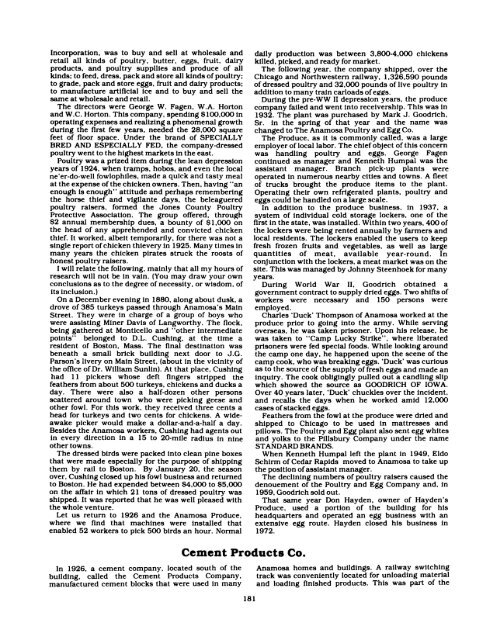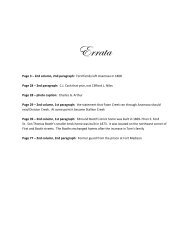Anamosa - A Reminiscence 1838 - 1988
The definitive history of the community of Anamosa, Iowa, USA
The definitive history of the community of Anamosa, Iowa, USA
Create successful ePaper yourself
Turn your PDF publications into a flip-book with our unique Google optimized e-Paper software.
Incorporation, was to buy and sell at wholesale and<br />
retail all kinds of poultry, butter. eggs. fruit, dairy<br />
products, and poultry suppllies and produce of all<br />
kinds: to feed, dress, pack and store all kinds of poultry;<br />
to grade. pack and store eggs, fruit and dairy products:<br />
to manufacture artificial ice and to buy and sell the<br />
same at wholesale and retail.<br />
The directors were George W. Fagen, W.A. Horton<br />
and W.C. Horton. This company, spending $100,000 in<br />
operating expenses and realizing a phenomenal growth<br />
during the first few years, needed the 28,000 square<br />
feet of floor space. Under the brand of SPECIALLY<br />
BRED AND ESPECIALLY FED, the company-dressed<br />
poultry went to the highest markets in the east.<br />
Poultry was a prized item during the lean depression<br />
years of 1924, when tramps, hobos, and even the local<br />
ne'er-do-well fowlophiles, made a quick and tasty meal<br />
at the expense of the chicken owners. Then, having “an<br />
enough is enough" attitude and perhaps remembering<br />
the horse thief and vigilante days. the beleaguered<br />
poultry raisers, formed the Jones County Poultry<br />
Protective Association. The group offered, through<br />
$2 annual membership dues, a bounty of $1,000 on<br />
the head of any apprehended and convicted chicken<br />
thief. It worked, albeit temporarily, for there was not a<br />
single report of chicken thievery in 1925. Many times in<br />
many years the chicken pirates struck the roosts of<br />
honest poultry raisers.<br />
I will relate the following, mainly that all my hours of<br />
research will not be in vain. [You may draw your own<br />
conclusions as to the degree of necessity. or wisdom. of<br />
its inclusion.)<br />
On a December evening in 1880, along about dusk, a<br />
drove of 385 turkeys passed through <strong>Anamosa</strong>‘s Main<br />
Street. They were in charge of a group of boys who<br />
were assisting Miner Davis of Langworthy. The flock,<br />
being gathered at Monticello and "other intermediate<br />
points” belonged to D.L. Cushing, at the time a<br />
resident of Boston, Mass. The final destination was<br />
beneath a small brick building next door to J.G.<br />
Parson's livery on Main Street, (about in the vicinity of<br />
the ofilce of Dr. William Sunlin). At that place. Cushing<br />
had ll pickers whose deft fingers stripped the<br />
feathers from about 500 turkeys. chickens and ducks a<br />
day. There were also a half-dozen other persons<br />
scattered around town who were picking geese and<br />
other fowl. For this work, they received three cents a<br />
head for turkeys and two cents for chickens. A wideawake<br />
picker would make a dollar-and-a-half a day.<br />
Besides the <strong>Anamosa</strong> workers, Cushing had agents out<br />
in every direction in a 15 to 20-mile radius in nine<br />
other towns.<br />
The dressed birds were packed into clean pine boxes<br />
that were made especially for the purpose of shipping<br />
them by rail to Boston. By January 20, the season<br />
over, Cushing closed up his fowl business and returned<br />
to Boston. He had expended between $4,000 to $5,000<br />
on the affair in which 21 tons of dressed poultry was<br />
shipped. It was reported that he was well pleased with<br />
the whole venture.<br />
Let us return to 1926 and the <strong>Anamosa</strong> Produce,<br />
where we find that machines were installed that<br />
enabled 52 workers to pick 500 birds an hour. Normal<br />
daily production was between 3,800-4,000 chickens<br />
killed, picked, and ready for market.<br />
The following year, the company shipped, over the<br />
Chicago and Northwestem railway, 1,326,590 pounds<br />
of dressed poultry and 32,000 pounds of live poultry in<br />
addition to many train carloads of eggs.<br />
During the pre-WW II depression years, the produce<br />
company failed and went into receivership. This was in<br />
1932. The plant was purchased by Mark J . Goodrich.<br />
Sr. in the spi1ng of that year and the name was<br />
changed to The <strong>Anamosa</strong> Poultry and Egg Co.<br />
The Produce, as it is commonly called, was a large<br />
employer of local labor. The chief object of this concern<br />
was handling poultry and eggs. George Fagen<br />
continued as manager and Kenneth Humpal was the<br />
assistant manager. Branch pick-up plants were<br />
operated in numerous nearby cities and towns. A fleet<br />
of trucks brought the produce items to the plant.<br />
Operating their own refrigerated plants, poultry and<br />
eggs could be handled on a large scale.<br />
In addition to the produce business, in 1937, a<br />
system of individual cold storage lockers, one of the<br />
first in the state, was installed. Within two years, 400 of<br />
the lockers were being rented annually by farmers and<br />
local residents. The lockers enabled the users to keep<br />
fresh frozen fruits and vegetables. as well as large<br />
quantities of meat, available year-round. in<br />
conjunction with the lockers, a meat market was on the<br />
site. This was managed by Johnny Steenhoek for many<br />
years.<br />
During World War II, Goodrich obtained a<br />
government contract to supply dried eggs. Two shifts of<br />
workers were necessary and 150 persons were<br />
employed.<br />
Charles ‘Duck’ Thompson of <strong>Anamosa</strong> worked at the<br />
produce prior to going into the army. While serving<br />
overseas, he was taken prisoner. Upon his release, he<br />
was taken to "Camp Lucky Strike", where liberated<br />
prisoners were fed special foods. While looking around<br />
the camp one day, he happened upon the scene of the<br />
camp cook, who was breaking eggs. ‘Duck’ was curious<br />
as to the source of the supply of fresh eggs and made an<br />
inquiry. The cook obligingly pulled out a candling slip<br />
which showed the source as GOODRICH OF IOWA.<br />
Over 40 years later. ‘Duck’ chuckles over the incident.<br />
and recalls the days when he worked amid 12,000<br />
cases of stacked eggs.<br />
Feathers from the fowl at the produce were dried and<br />
shipped to Chicago to be used in mattresses and<br />
pillows. The Poultry and Egg plant also sent egg whites<br />
and yolks to the Pillsbury Company under the name<br />
STANDARD BRANDS.<br />
When Kenneth Humpal left the plant in I949. Eldo<br />
Schirm of Cedar Rapids moved to <strong>Anamosa</strong> to take up<br />
the position ofassistant manager.<br />
The declining numbers of poultry raisers caused the<br />
denouement of the Poultry and Egg Company and. in<br />
1959, Goodrich sold out.<br />
That same year Don Hayden, owner of Hayden's<br />
Produce, used a portion of the building for his<br />
headquarters and operated an egg business with an<br />
extensive egg route. Hayden closed his business in<br />
1972.<br />
In 1926, a cement company, located south of the<br />
building, called the Cement Products Company.<br />
manufactured cement blocks that were used in many<br />
Cement Products Co.<br />
181<br />
<strong>Anamosa</strong> homes and buildings. A railway switching<br />
track was conveniently located for unloading material<br />
and loading finished products. This was part of the



